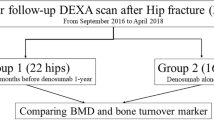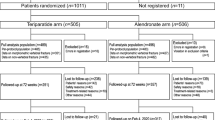Abstract
Summary
In this retrospective study, the effectiveness of short-term teriparatide with denosumab in reducing fragility fracture risk was determined in comparison with denosumab monotherapy. Administration of sequential teriparatide with denosumab showed excellent outcomes in suppressing the risk for fragility fractures compared with denosumab monotherapy.
Introduction
To determine the effectiveness of short-term teriparatide with denosumab in reducing the risk of fragility fractures in comparison to denosumab monotherapy.
Methods
The data of postmenopausal patients treated with denosumab for > 2 years between August 2015 and October 2020 were retrospectively analyzed. One hundred sixty four postmenopausal women of a total 615 were excluded, since they did not undergo > 2 bone mineral density (BMD) tests, were lost to follow-up, or received long-term teriparatide therapy. Total 320 patients received denosumab monotherapy and 131 patients received teriparatide for ≥ 3 months followed by denosumab. The number of osteoporotic fractures, presence of back pain before and after treatment, and annual BMD during treatment were comparatively assessed using t-test, Chi-square test, and linear mixed model analysis.
Results
Before treatment, the denosumab monotherapy group had fewer osteoporotic fractures (mean ± standard deviation; 0.459 ± 0.689) than the sequential therapy group had (1.037 ± 0.871; p < 0.001). After treatment, the sequential therapy group had fewer osteoporotic fractures than the denosumab monotherapy group had (0.119 ± 0.348 versus 0.144 ± 0.385; p < 0.001). At 1 and 2 years after treatment, the increase in lumbar spine BMD was greater in the sequential therapy group than in the denosumab monotherapy group (p = 0.08, group × time). The difference between post and pre-treatment back pain visual analog scale score was significantly lower in the sequential therapy group than in the monotherapy group (3.246 ± 3.426 versus 1.734 ± 3.049; p < 0.001).
Conclusion
Short-term teriparatide use before denosumab showed excellent outcomes in suppressing the risk of fragility fractures compared with denosumab monotherapy.




Similar content being viewed by others
Data availability
The authors confirm that the data supporting the findings of this study are available within the article and its supplementary material. Raw data that support the findings of this study are available from the corresponding author, upon reasonable request.
References
Ramchand SK, David NL, Lee H et al (2021) Effects of combination denosumab and high-dose teriparatide administration on bone microarchitecture and estimated strength: the DATA-HD HR-pQCT study. J Bone Miner Res 36:41–51. https://doi.org/10.1002/jbmr.4161
Black DM, Rosen CJ (2016) Clinical practice. Postmenopausal osteoporosis N Engl J Med 374:254–262. https://doi.org/10.1056/NEJMcp1513724
Kani JA (1994) Assessment of fracture risk and its application to screening for postmenopausal osteoporosis In Report of a WHO Study Group. World Health Organ Tech Rep Ser 843:1–129
Compston JE, McClung MR, Leslie WD (2019) Osteoporosis Lancet 393:364–376. https://doi.org/10.1016/S0140-6736(18)32112-3
Cummings SR, San Martin J, McClung MR et al (2009) Denosumab for prevention of fractures in postmenopausal women with osteoporosis. N Engl J Med 361:756–765. https://doi.org/10.1056/NEJMoa0809493
Bone HG, Wagman RB, Brandi ML et al (2017) 10 years of denosumab treatment in postmenopausal women with osteoporosis: results from the phase 3 randomised FREEDOM Trial and open-label extension. Lancet Diabetes Endocrinol 5:513–523. https://doi.org/10.1016/S2213-8587(17)30138-9
Neer RM, Arnaud CD, Zanchetta JR et al (2001) Effect of parathyroid hormone (1–34) on fractures and bone mineral density in postmenopausal women with osteoporosis. N Engl J Med 344:1434–1441. https://doi.org/10.1056/NEJM200105103441904
Tsai JN, Uihlein AV, Lee H et al (2013) Teriparatide and denosumab, alone or combined, in women with postmenopausal osteoporosis: the DATA study randomised trial. Lancet 382:50–56. https://doi.org/10.1016/S0140-6736(13)60856-9
Leder BZ, Tsai JN, Uihlein AV et al (2014) Two years of denosumab and teriparatide administration in postmenopausal women with osteoporosis (The DATA Extension Study): a randomized controlled trial. J Clin Endocrinol Metab 99:1694–1700. https://doi.org/10.1210/jc.2013-4440
Tsai JN, Uihlein AV, Burnett-Bowie SM et al (2016) Effects of two years of teriparatide, denosumab, or both on bone microarchitecture and Strength (DATA-HRpQCT study). J Clin Endocrinol Metab 101:2023–2030. https://doi.org/10.1210/jc.2016-1160
Tsai JN, Uihlein AV, Burnett-Bowie SA et al (2015) Comparative effects of teriparatide, denosumab, and combination therapy on peripheral compartmental bone density, microarchitecture, and estimated strength: the DATA-HRpQCT Study. J Bone Miner Res 30:39–45. https://doi.org/10.1002/jbmr.2315
Kang JH, Yang SM, Im SB, Jeong JH (2019) Can three months of teriparatide be one of treatment options for osteoporotic vertebral compression fracture patients. Korean J Neurotrauma 15:19–27. https://doi.org/10.13004/kjnt.2019.15.e13
Eastell R, Rosen CJ, Black DM, Cheung AM, Murad MH, Shoback D (2019) Pharmacological management of osteoporosis in postmenopausal women: an Endocrine Society* clinical practice guideline. J Clin Endocrinol Metab 104:1595–1622. https://doi.org/10.1210/jc.2019-00221
Meunier PJ, Boivin G (1997) Bone mineral density reflects bone mass but also the degree of mineralization of bone: therapeutic implications. Bone 21:373–377. https://doi.org/10.1016/s8756-3282(97)00170-1
Currey JD (1990) Physical characteristics affecting the tensile failure properties of compact bone. J Biomech 23:837–844. https://doi.org/10.1016/0021-9290(90)90030-7
Burr DB, Turner CH, Naick P et al (1998) Does microdamage accumulation affect the mechanical properties of bone? J Biomech 31:337–345. https://doi.org/10.1016/s0021-9290(98)00016-5
Seeman E, Delmas PD (2006) Bone quality–the material and structural basis of bone strength and fragility. N Engl J Med 354:2250–2261. https://doi.org/10.1056/NEJMra053077
Fratzl P, Gupta HS, Paschalis EP, Roschger P (2004) Structure and mechanical quality of the collagen–mineral nano-composite in bone. J Mater Chem 14:2115–2123. https://doi.org/10.1039/B402005G
Laib A, Kumer JL, Majumdar S, Lane NE (2001) The temporal changes of trabecular architecture in ovariectomized rats assessed by MicroCT. Osteoporos Int 12:936–941. https://doi.org/10.1007/s001980170022
Boyd SK, Davison P, Müller R, Gasser JA (2006) Monitoring individual morphological changes over time in ovariectomized rats by in vivo micro-computed tomography. Bone 39:854–862. https://doi.org/10.1016/j.bone.2006.04.017
Ammann P, Rizzoli R, Meyer JM, Bonjour JP (1996) Bone density and shape as determinants of bone strength in IGF-I and/or pamidronate-treated ovariectomized rats. Osteoporos Int 6:219–227. https://doi.org/10.1007/BF01622738
Tokeshi S, Eguchi Y, Suzuki M et al (2021) Relationship between skeletal muscle mass, bone mineral density, and trabecular bone score in osteoporotic vertebral compression fractures. Asian Spine J 15:365–372. https://doi.org/10.31616/asj.2020.0045
Ueno M, Toriumi E, Yoshii A, Tabata Y, Furudate T, Tajima Y (2021) Use of parathyroid hormone and rehabilitation reduces subsequent vertebral body fractures after balloon Kyphoplasty. Asian Spine J. https://doi.org/10.31616/asj.2020.0608
Kim WJ, Ma SB, Shin HM et al (2021) Correlation of sagittal imbalance and recollapse after percutaneous vertebroplasty for thoracolumbar osteoporotic vertebral compression fracture: A multivariate study of risk factors. Asian Spine J. https://doi.org/10.31616/asj.2021.0062
Acknowledgements
We would like to thank Editage (www.editage.com) for English language editing.
Author information
Authors and Affiliations
Corresponding author
Ethics declarations
Ethical approval
This single-center retrospective review was conducted with the approval of the institutional review board of the Gangnam Severance Hospital, College of Medicine, Yonsei University (Approval number: 3-2020-0442). The research was conducted in accordance with the Helsinki Declaration and its later amendments.
Informed consent
The requirement for obtaining patient informed consent was waived owing to the retrospective nature of this study.
Conflict of interest
None.
Additional information
Publisher's note
Springer Nature remains neutral with regard to jurisdictional claims in published maps and institutional affiliations.
Supplementary Information
Below is the link to the electronic supplementary material.
Rights and permissions
About this article
Cite this article
Shin, JW., He, Q., Suk, Y.J. et al. Comparison of the efficacy between sequential therapy with teriparatide and denosumab and denosumab monotherapy in suppressing fragility fracture risk. Osteoporos Int 33, 2409–2416 (2022). https://doi.org/10.1007/s00198-022-06495-8
Received:
Accepted:
Published:
Issue Date:
DOI: https://doi.org/10.1007/s00198-022-06495-8




